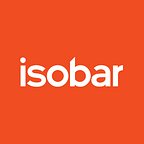A snapshot of the best bits from day two of Spikes Asia
Alina Morais, Regional PR Manager, APAC, picks out the best bits from day two of Spikes Asia Festival of Creativity in Singapore.
So day two of Spikes Asia Festival of Creativity dawned bright and early and as there were no Isobar sessions today, I got the opportunity to sit in on some sessions throughout the day on new digital marketing technology.
Your personal ad
In an eye-opening talk on ‘programmatic creative’ presented by Xaxis’ Rohan Philips, its APAC VP for Products and Strategy, makes a case for data-driven design. He spoke about computer-generated ads that will automatically build itself at run-time using a mix of artificial intelligence and machine learning, to determine which elements (images, copy, messaging) to use.
While there are nearly endless permutations for relevant advertising, there isn’t an endless pool of creative to deliver. Typically, if brands don’t want to use the same creative across different audiences, they would need to go through the laborious process of creating multiple pieces of creatives, corresponding to the audience targeting.
Here’s an interesting stat — only 22% of marketers regularly use data to adapt a creative. So the whole idea is to use data and tech to help brands engage with audiences at scale, while being extremely targeted.
Rohan then did a quick demo of how a programmatic creative can be created using a template and existing data that is already available on an individual (for example via their Facebook profile). Each layer of personalisation of creative leads to better performance. This all goes beyond programmatic ads and media buys and has the capability to really change the way a marketer puts out an ad.
Human-like machines
In a session held by Havas that also spoke to today’s consumer need for more personalized brand interactions, cognitive systems were touted as yet another game changer. It is well-acknowledged that the huge amount of big data available usually ends up being dark data. But Jason Jercinovic, Havas’ Global Head of Marketing Innovation, spoke about the potential to be had through the use of cognitive systems.
While today’s tech is already delivering benefits by automation, computational processing and programming, the machines of tomorrow have the capability to go further and help people extend their expertise across any domain of knowledge and to make complex decisions involving extraordinary volumes of data.
The typical attributes of a cognitive system are that it is able to understand, reason, learn and interact. Stating that cognitive systems can shine a light on dark data and are more human-like, Jason shared that cognitive systems, if done well, never stop learning. Therefore, the possibilities are endless as it has the capability to reinvent a brand’s interaction with their customers, not in a robot-like way, but in a more natural way.
I honestly found it all fascinating as data and technology are constantly changing the way marketers and advertisers do their job. But technology and machines aside, I still think sometimes it’s the simple things that matter such as good old fashioned creativity.
Oldie but goodie
In my personal, most favourite session of the day, I sat in on Tony Hertz’s session on how to present radio so the clients won’t kill it. Radio is often perceived as the poorer cousin to TV and is far down the line when clients turn to ad agencies, but if done right radio can be as impactful as a TV ad.
Advertising is 100% visual, so why would clients want to read something when they can be shown something. Typically, clients don’t know how to read radio scripts, we need to show them radio they can see.
Tony shared that the whole idea is to visualize your radio as it’s the imagery that makes great radio. He took us through a brief workshop where he played a piece of music. In categories pre-assigned to us (personal care, drink, relationship and clothing), he then asked us to draw what we saw when we listening to that piece of music. As you can imagine, everyone saw something different even if they had the same category as that one piece of music triggered different images and emotions.
So how can we maximize that knowledge in radio advertising? By telling people what they can see. That involves thinking of a visual idea and finding a way to bring that visual idea to life using sound, words, etc. He proceeded to shared two simple but impactful radio advertisements that demonstrated creative imagery in radio (couldn’t find a link to share unfortunately!) as well as seven good ways to present radio to your client:
1. Tell the story
2. Use a graphic
3. Mood board
4. Storyboard
5. Radio typography
6. Demo
7. Script
In short, it’s time for the industry to stop looking at radio as the poorer cousin, but rather, find creative ways to write, picture and present more adventurous radio. And Tony should know what he’s talking about. To date, he remains the only person to win both a Black and Yellow D&AD Radio Pencil and the only person to serve three times on the Radio jury at Cannes Lions.
Stay tuned for more news from Isobar at Spikes Asia 2016 and follow us on social for live updates:
